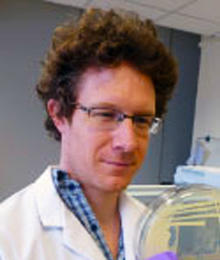An interview with Simon Gregory
May 2020
Dr Simon Gregory has taken a circuitous route through neuroscience, human population genetics and aquaculture to get to where he is now, leading the geomicrobiology research at the British Geological Survey. His current research interests include microbial aspects of radioactive waste disposal, carbon capture and storage, geothermal energy, biomining and methane cycling. Read more about his research in this interview.

Tell us more about your research.
What lies beneath our feet is a mystery to most of us, especially once we start thinking about what is below the depth of concrete and soil.
In amongst the rocks and groundwater, life continues down to depths of several kilometres. At depth, limited nutrients and carbon sources, or lack of space and available water means that, in general, life goes on at a gentle pace; microbes are sparse and go about their business of growing, dividing and recycling nutrients in a slow and steady way.
These ecosystems are of interest to those trying to understand extremophiles – life on early Earth, or the possibilities of life on other planets. However, what interests me the most is what happens to these microbial communities when we start intruding into this world, and how this can impact the environment, or our use of the subsurface.
As a society, we are increasingly looking to the subsurface to extract resources such as water, minerals, heat, hydrocarbons, to dispose of waste (including radioactive waste) or to store gases for carbon sequestration or energy storage. Whenever we drill, excavate, introduce or remove materials, we can change the environment in which microbes live and can disturb the delicate balance of subterranean microbial ecosystems.
These activities may introduce nutrients, carbon and space which can affect the abundance and activity of micro-organisms.
Why is this research important?
If nutrients in drilling fluids stimulate microbial growth, their by-products could reduce flow in wells associated with geothermal energy or carbon dioxide storage. If gases such as methane and hydrogen are stored for their energy potential can be consumed by micro-organisms or be converted into other unwanted gases. Microbes that can grow and contribute to metal corrosion may cause damage to infrastructures associated with radioactive waste containment barriers.
By looking at these sorts of processes we aim to learn about the impact of micro-organisms in engineered subsurface environments, to ensure that microbial processes can be understood and their impact quantified. This is so that there are no unexpected consequences of human activity that could affect the success and safety of our use of the subsurface, or the environment.


